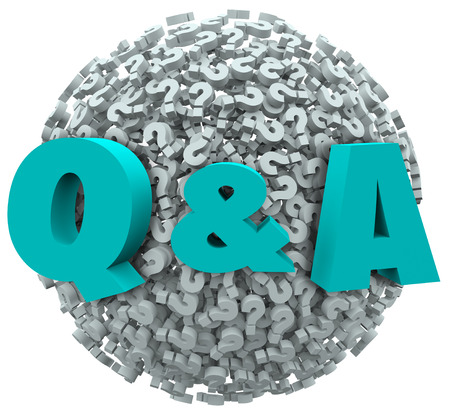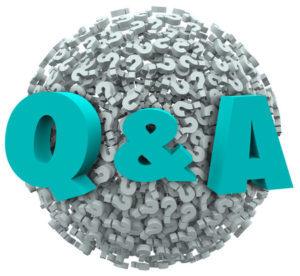
by Beth Levine | Aug 1, 2017 | preparing for a presentation, public speaking
 Managing Q&A effectively requires you to have a good offensive game strategy. What this means is being mentally ready with an approach for how you want to field and answer questions no matter what you get asked.
Managing Q&A effectively requires you to have a good offensive game strategy. What this means is being mentally ready with an approach for how you want to field and answer questions no matter what you get asked.
Three things are important to keep in mind before we get into Q&A game strategy:
- Q&A is quite possibly your only guaranteed opportunity to know you are answering your audience’s WIIFM (what’s-in-it-for-me) needs, so embrace it!
- You want to field as many questions as you can, from as many audience members as you can, so keep your answers concise.
- It is TOTALLY OKAY not to know an answer, just say so and then offer to find the answer and get back to the person asking.
Your 5-point offensive game strategy:
1. Pause for one or two seconds after the question is asked to collect your thoughts so you can execute on points 2-5 below.
2. Ask yourself, was that a question or a speech? Speeches may not require more than an acknowledgment. If it’s a combination of a speech followed by a question, your best tack is to just answer the question.
3. Don’t focus on the words used in the question, instead search for the theme of the question. In other words, don’t be baited by and then respond to negative language. Listen for the bigger picture theme of the question, it’s a much better springboard to an answer.
4. Find one of your message points that aligns with the theme and begin your answer with a message point. Message points are great springboards, they set context so you can provide meaningful information in your responses.
5. Bridge or redirect, if necessary, back to one of your message points or to your topic. Bridging isn’t evading, it’s getting back on topic.
Q&A can be tricky and it’s always an unknown, but look at it as a triple-bonus – it’s when you get to connect most directly with your audience, it’s when you get to weave in material you might have mistakenly omitted during your presentation, and it’s when you get to reinforce your key points.

by Beth Levine | Jul 2, 2017 | preparing for a presentation, public speaking
Gearing up to make a speech or presentation can be daunting for two main reasons – one is the challenge of organizing your thoughts and material into something interesting and compelling; the other is the challenge of managing yourself, your nerves, and the dread that comes with anticipating the faces, opinions and judgment of an audience.

For the first one, click on the highlighted link to access our tool that can help you. But for the second one, let’s try and put that into perspective right here, right now.
To that end, I’d like to offer 3 proven facts for you to use as “notes to self” when you find yourself thinking up excuses you can use to back out of your speaking commitment. I bet you didn’t know – or maybe when anxious, you’ve suppressed – these 3 tested and true facts:
Did you know that …
1. Audiences cannot tell you’re nervous.
Unless you call it out or unless it’s very – and I mean very – exaggerated, audiences cannot tell you’re shaking, not breathing normally, or sweating. There have been surveys around this, and it turns out the vast majority of audiences cannot see the manifestation of nervousness in speakers. Anecdotally, I can tell you I’ve worked with groups in which the participants have had to give mock presentations to each other and – without fail – these peer audiences have not noticed when their colleagues were shaking or couldn’t breathe. Interesting!
Bottom line: Know that what you are feeling, while it seems blatantly obvious to you, is going to be invisible to your audience. And no matter what, don’t call it out!
2. Audiences don’t know when you’ve skipped or forgotten something.
Of the many ways to fluster yourself, skipping or forgetting a chunk of your material while delivering your talk is right up there on the list of top flusterers. Nonetheless, I can guarantee you that you’ll be the only one distracted by it. Your audience won’t know. So even if, worst-case scenario, you moved clumsily from your first point to your third point and it sounded like a non-sequitur to your audience, they’ll get past the rough transition and join you in your third point … and they still won’t know.
Bottom line: Know that what you skipped, while it seems like a blatant omission to you, is not noticeable to your audience. And no matter what, don’t call it out!
3. Audiences are on your side, they expect you to succeed.
Yes, the home court advantage is yours! Audiences are passive, they’re just waiting for – and expecting – you to do a good job. In fact, they’re glad the responsibility is on someone else, and they assume that since you were invited to go to the front of the room, you have the gravitas for it and you’ll do just fine. No one is sitting there waiting for you to fall on your face (like you might be?). Your audience is waiting for you to connect with them and offer them something of value, something new or useful. So be sure to do that!
Bottom line: Know that your audience is not judging you harshly, they’re actually waiting for you to enlighten them. And no matter what, don’t open with disclaimers or qualifiers about how prepared/unprepared you are or how confident/insecure you are about your topic.
Audiences are people, just like you. Observe yourself when you’re listening to a speaker/presenter and make more “notes to self” that will help you the next time you get up to speak!

by Beth Levine | Jun 19, 2017 | preparing for a presentation, public speaking
 Last week, I delivered four different talks, all of which were the full monty – large audiences, microphones, PowerPoint decks, four different topics. It was daunting, but not because of nervousness or fear of forgetting my content. It was daunting because of all the multitasking involved with, and required of, being a good speaker.
Last week, I delivered four different talks, all of which were the full monty – large audiences, microphones, PowerPoint decks, four different topics. It was daunting, but not because of nervousness or fear of forgetting my content. It was daunting because of all the multitasking involved with, and required of, being a good speaker.
There are multitudes of public speaking worries that are talked about, yet for some reason multitasking is one that gets woefully overlooked. For me, and for many, the multitasking involved in being an effective – let alone, dynamic and compelling – public speaker might well be the most taxing aspect of going to the front of the room.
Here’s a random sampling of what multitasking looks like for me:
Do I look okay?
Am I smiling and appearing welcoming?
Is the sound working?
Am I projecting well enough?
Is the technology working?
Was I compelling in my first 8 seconds?
Am I connecting with this group?
Am I transitioning well from slide to slide, section to section so that it makes sense to them?
Am I moving around the floor too much/too little?
Is my speaking pace okay?
Am I providing enough time for them to digest the material?
Am I looking around the room at as many faces, or segments of the room, as possible?
Should I engage them now, should I maybe break for a midpoint Q&A?
Are they with me, do they get it?
How’s my energy, voice and body?
Am I sensing that the next section of my content won’t really interest them, should I skip it?
Are my glances at the screen subtle and few?
Am I hitting all the points I planned to make and, wait, do I remember what comes next?
Can you relate to some, or maybe all, of these? Are you with me, do you get it? I’m guessing the answers are yes and yes. Is it overwhelming and sometimes literally daunting? Yes and yes.
There’s no single cure or technique for conquering or mastering multitasking, but here are 3 basic tactics that can provide some relief:
1. Know your content. Be fluent with the flow, especially with the actual statements (i.e. the sentences) that are your major message points. Pay attention to and prepare your transitions and pauses.
2. Plan not only your content, but your choreography too – you, your visuals, your body language and gestures, your movement around the stage or room. Know, and then rehearse, your choreography with your content.
3. Let her rip! At a certain point, you need to let go of all your multitasking worries and just be present with your audience. Release yourself to them, talk to them, be with them and trust that you’re prepared and the rest will come.
It all boils down to this: good preparation. And then, even with good preparation under your belt, when it’s show time, you need to let go and be with your audience.
Good luck out there, and let me know how it’s going!
by Beth Levine | Jun 6, 2017 | preparing for a presentation, public speaking
 Have an upcoming presentation? Sweating it? Don’t know where to begin?
Have an upcoming presentation? Sweating it? Don’t know where to begin?
The only thing that matters, the one and only thing that should guide you – along with your topic, of course – is your audience. Yes, it’s that simple: your audience makes all critical presentation decisions for you.
As you develop your main ideas or key message points for your presentation, your audience is your go-to source for inspiration. Think about who they are and what they really care about? Who are they – peers, colleagues, influencers, decision-makers? What do they really care about – time, money, impact, quality, their own jobs? What’s in it for them, what keeps them up at night? And therefore, what are the main ideas or themes you should hit on?
Angle your material toward your audience.
Think about why they are in the room. Are they obligated to be there? If so, keep it brief and avoid TMI. Or did they choose to be there? If so, you have a little more latitude with time and detail.
You also will want to plan to bring them along on the journey that is your presentation. What I mean by that is you will literally want to bring them along, you will want to guide them through your presentation – e.g. letting them know where you are, what’s next, what their takeaways are supposed to be, when you’re digressing to share a story, and when you’re back on track.
Audiences are passive and are not required to work hard. You, the speaker, are in the active role and are required to work hard. The work of building understanding, appreciation and/or aha! moments is on you, not on your audience. You bear the responsibility of guiding them through your material and toward your conclusions, you cannot assume they’ll get there on their own.
The solution in a word? Spoonfeed. If you want your audience to know or understand or do something, spoonfeed it, spell it out. Otherwise, it is likely to be lost. People do not connect their own dots.
Just remember that audiences will not do any work to figure out what you’re telling them. They are waiting for you to give them something new or useful or worthwhile. Above all, they are waiting for you to give them something that’s valuable and relevant (to them, not to you).
Think about it, angling your material toward what you know about your audience’s interests is the least you can do in exchange for their time and attention!
by Beth Levine | May 16, 2017 | preparing for a presentation, public speaking
 If you’re delivering a talk or presentation, questions are your best friend.
If you’re delivering a talk or presentation, questions are your best friend.
I’m not referring to the questions your audience asks you during Q&A – no doubt, those are really important too – but I’m referring to the questions you ask your audience.
Here’s my triple-win rationale for speakers posing questions to their audiences:
First, if you tend to get nervous, you can throw a question or two to the audience as a way to give yourself a little breather. The first 120 seconds of a presentation are the most anxiety-provoking – that’s when you’re the most nervous and probably not breathing normally – and so posing a question to the audience will give you an opportunity to share the floor and grab enough time for a nice, hopefully calming, inhale and exhale.
Second, we all know from our experience as audience members that we like to be engaged, it holds our attention better. Questions therefore are a great tool for connecting with and engaging your audience – inviting them to access their own knowledge or experiences around your topic, making them question biases or misconceptions about your topic, getting them to think. These are all good, as they will help you open your audience’s minds to hear what you have to say.
Third, questions are a change in stimulation during a talk or presentation. They are attention-grabbing and will wake up any sleepers or daydreamers in the room. I often get asked how to bring back an audience’s attention when you feel like they’re fading or drifting. Well, asking them questions is one perfectly good way!
Here are three tips for using questions effectively:
1. Prepare your questions in advance and know when you’re going to ask them. Note of caution: You’ll also need to be ready to answer the questions yourself in the unlikely, but possible, event of radio silence from the audience.
2. Make sure the questions do a good job of queuing up your next point – or, in the case of an opening question, queuing up your whole talk.
An example of this is a sports arena executive I worked with a few years back who was often invited to speak to Rotary Clubs and other local business groups. He would open his presentations by asking his audiences to guess how many rolls of toilet paper they thought the arena went through in a year. This was such an entertaining way to spark the audience’s thoughts about the vast numbers of visitors and diversity of events at the arena, which supported his overall message that the arena entertains an entire region!
3. If you ask a question and people answer, please be sure to acknowledge and repeat back as many of the answers as you can. This not only fuels the engagement between speaker and audience, but it also recognizes audience members for making an effort.
by Beth Levine | May 2, 2017 | preparing for a presentation, public speaking
 Since when did the word “presentation” become synonymous with PowerPoint? Why is it there’s an automatic assumption when you walk into a room to talk — even to only 10 people and even for only 10 or 20 minutes – that you will use slides? In fact, the screen awaits you, and your host tells you where and how to hook up your laptop without ever having asked you in advance.
Since when did the word “presentation” become synonymous with PowerPoint? Why is it there’s an automatic assumption when you walk into a room to talk — even to only 10 people and even for only 10 or 20 minutes – that you will use slides? In fact, the screen awaits you, and your host tells you where and how to hook up your laptop without ever having asked you in advance.
Yet if you were to poll the people in the room (and I always do!), they are most often 100% unanimous in saying they strongly dislike PowerPoint and prefer that you not use it. This is due to the overuse and misuse of PowerPoint – which, ironically, is due to the automatic assumption that you’re going to, which is due to the fact that “presentation” has become synonymous with PowerPoint.
As a longtime whiteboard user (I draw a lot of pictures and write out words and phrases when talking to groups), I have spent many years gloating over my informal poll results that reveal universal disdain for PowerPoint. After all, my stick figure drawings and primitive renderings of houses, fish, and bullseyes are more clever and amusing than some slick PPT template, right?!
Right in only one way: Audiences do tend to remember and retain visuals better when they watch them come alive so to speak. Well, and maybe they’re also a little bit amusing.
But wrong in other ways.
Last week, after a whiteboard talk and one of my informal polls – “By a show of hands, how many of you wish I had used PowerPoint?” Total hands raised: 0 – the audience groaned and moaned about how useless PowerPoint is and how glad they were that I didn’t turn down the lights and make them stare at a screen.
And then it happened. I found myself defending PowerPoint as an incredibly useful tool. “It’s not dreadful, it’s a fantastic visual aid,” I implored, “and most people are visual learners and need visual reinforcement.” All true.
I went on to point out that what is dreadful is how people use PowerPoint, which is as a script or as a substitute for a handout (suffice it to say, you know what and who I’m talking about). Slides dense with words are the worst, but the list of offenses committed via PowerPoint is endless.
Personally, I think this is a Monkey-See-Monkey-Do issue. People follow the model of what they’ve seen before and with 30 million PowerPoint presentations per day in the U.S. (that’s according to the Wall Street Journal), you can see how bad habits might form by mindlessly following others. People just need permission to approach PowerPoint differently.
So here are 6 permissions I will give you:
- You may use one word on a slide. Large font, centered.
- You may use an image or a graphic with no words. You will provide the words and the meaning as you talk.
- You may even use a spreadsheet but only if you enlarge or circle in a very bright color the number(s) or section you will be talking about.
- You may have only a few, versus a few hundred, slides.
- You may show your dog, or an image of yourself skiing.
- You may prepare your PowerPoint after you’ve organized your thoughts and decided what you’re going to say, if you have time, and if you don’t have time, use a white board.
These are just a start, but feel free to go outside the box of what you’ve seen others do. Just keep in mind these two words: visual reinforcement. Explanation and narration come from the presenter.

 Managing Q&A effectively requires you to have a good offensive game strategy. What this means is being mentally ready with an approach for how you want to field and answer questions no matter what you get asked.
Managing Q&A effectively requires you to have a good offensive game strategy. What this means is being mentally ready with an approach for how you want to field and answer questions no matter what you get asked.



 Last week, I delivered four different talks, all of which were the full monty – large audiences, microphones, PowerPoint decks, four different topics. It was daunting, but not because of nervousness or fear of forgetting my content. It was daunting because of all the multitasking involved with, and required of, being a good speaker.
Last week, I delivered four different talks, all of which were the full monty – large audiences, microphones, PowerPoint decks, four different topics. It was daunting, but not because of nervousness or fear of forgetting my content. It was daunting because of all the multitasking involved with, and required of, being a good speaker. Have an upcoming presentation? Sweating it? Don’t know where to begin?
Have an upcoming presentation? Sweating it? Don’t know where to begin? If you’re delivering a talk or presentation, questions are your best friend.
If you’re delivering a talk or presentation, questions are your best friend. Since when did the word “presentation” become synonymous with PowerPoint? Why is it there’s an automatic assumption when you walk into a room to talk — even to only 10 people and even for only 10 or 20 minutes – that you will use slides? In fact, the screen awaits you, and your host tells you where and how to hook up your laptop without ever having asked you in advance.
Since when did the word “presentation” become synonymous with PowerPoint? Why is it there’s an automatic assumption when you walk into a room to talk — even to only 10 people and even for only 10 or 20 minutes – that you will use slides? In fact, the screen awaits you, and your host tells you where and how to hook up your laptop without ever having asked you in advance. 

